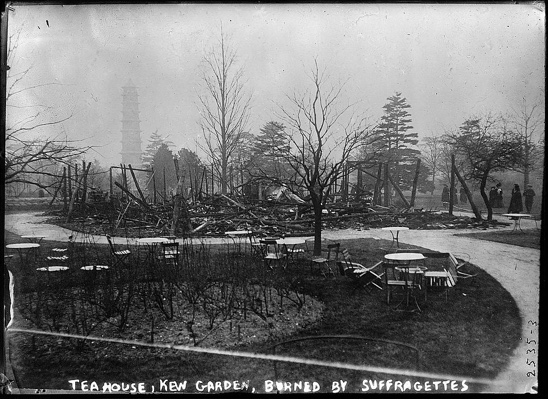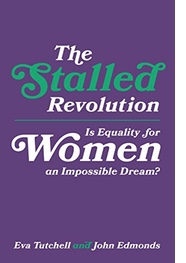What’s Missing from the Centenary Celebration of Women’s Suffrage in Britain?

Tea House, Kew Gardens, burned by suffragettes
Parliament Square in London is filled with statues of the famous. But there is no gender balance; all the statues are of men. This year, at last, the male exclusivity is to be broken. A statue has been commissioned of Millicent Fawcett, a leader of the campaign to secure votes for British women.
Fawcett had to wait a long time for recognition. This year is the hundredth anniversary of the Act of Parliament which first granted votes to women. Unfortunately, in a typical example of British half-heartedness, not all women won the vote in 1918. It only went to women over the age of 30. Nevertheless the anniversary was celebrated with enthusiasm. Prime Minister Theresa May made a grand speech, parades and parties were held, there were programmes on television and radio and many pages of newsprint described the suffrage campaign and its leading personalities.
 However, as with many celebrations of historic events, some of the most contentious issues were conveniently forgotten. The celebrations focused on images of elegant women making speeches to large crowds and of the suffrage campaigners chaining themselves to railings in London’s Hyde Park. There was scarcely a mention of the rougher side of the campaign – the violence of the police, the heavy prison sentences and the suffering of the demonstrators who went on hunger strikes and were forcibly fed with appalling brutality.
However, as with many celebrations of historic events, some of the most contentious issues were conveniently forgotten. The celebrations focused on images of elegant women making speeches to large crowds and of the suffrage campaigners chaining themselves to railings in London’s Hyde Park. There was scarcely a mention of the rougher side of the campaign – the violence of the police, the heavy prison sentences and the suffering of the demonstrators who went on hunger strikes and were forcibly fed with appalling brutality.
Not all the women campaigners were as well-behaved as Prime Minister Theresa May made them appear. In the years immediately before the First World War, a significant group of campaigners – the Suffragettes, led by Emmeline Pankhurst – rejected the peaceful methods advocated by Fawcett and waged a militant campaign of violent destruction.
Initially soft targets were chosen. Post boxes were filled with varnish. Art galleries and museums were vandalized. Important works of art were damaged in London, Manchester and Birmingham.
But the campaign had a much darker side. Instructions issued by Emmeline Pankhurst and her daughter Christabel recommended the use of arson and bombs. Houses owned by politicians and other prominent persons were blown up, including the Surrey home of the Liberal Minister, David Lloyd George. Three Scottish castles were destroyed in a single night. The Theatre Royal in Dublin suffered an arson attack. Racecourse Stands were burned down. Bombs were exploded in Westminster Abbey, St. John’s church in Westminster and St. Martin’s in the Fields. Ancient churches in the Midlands were destroyed. In the early months of 1914, serious attacks were being reported at the rate of nearly one a day.
The campaign of violent destruction was not popular with all of Pankhurst’s followers. Care was taken to choose times when the target buildings were thought to be empty but the possibility of death and injury was always present. It was too much for two of Emmeline Pankhurst’s greatest allies who left the campaign. Even Emmeline’s own daughter, Sylvia, expressed doubts. But Emmeline Pankhurst offered no excuses. The militancy was needed to seize the attention of politicians: “You have to make more noise than anyone else, you have to be more obtrusive than anyone else, you have to fill all of the papers more than anyone else.”
We can never be sure whether the campaign of destruction helped to win the vote for women. Emmeline Pankhurst’s argument has substance, but the escalation of violence might not have been necessary and certainly put the suffrage campaign in jeopardy, as I argue in The Stalled Revolution,Is Equality for Women an Impossible Dream?
When the policy of violent destruction was launched, Emmeline Pankhurst was already one of the most famous women in Britain. And after years of vigorous and ingenious campaigning, the Suffragettes were well equipped to attract publicity without the use of arson of bombs.
The boycotting of the 1911 census had produced press reports across Britain. An air balloon was used to shower leaflets down onto London. Suffragettes had provoked the Westminster authorities into much delightful nonsense by chaining themselves to the furniture in Parliament. Suffragettes had packaged and posted themselves to intransigent politicians. Suffragette flags were placed on the greens of the Balmoral golf course, next to the royal castle. Pankhurst demanded the right under ancient law to petition the King. Suffragette Annie Kenney invaded Lambeth Palace to lobby the Archbishop of Canterbury who, nonplussed, offered her tea. There was no shortage of stories to fill the newspapers.
Suffrage campaigners who stayed within the law criticized Emmeline Pankhurst for her recklessness. Millicent Fawcett feared that arson and bombs directed at a host of apparently random targets would encourage the Government to repeat the ancient claim that women did not have the judgement and maturity to take part in Parliamentary elections.
Yet instead of launching a new propaganda attack, the Government held back. Why it did so has never been entirely clear but the best explanation is not that Ministers were afraid of the violence of the Suffragettes but rather that that they were aware of the “soft” power of Millicent Fawcett’s own organization.
Some of the most prominent women in the land were members of Suffrage Societies in Millicent Fawcett’s National Union. These included the wives, sisters and daughters of MPs and Lords. The Government could condemn the methods employed by the Suffragettes, but after years of campaigning any suggestion that women lacked political maturity would have prompted outrage in many powerful families. The influence of Fawcett and her followers acted as a shield that protected the cause of women’s suffrage from any damaging political reaction to the escalation of violence.
It is a pity that the recent British celebrations featured only one part of the suffrage story. The campaign was militant as well as law-abiding, violent as well as decorous. The Suffragettes gave it excitement and momentum while Fawcett’s constitutional Suffrage Societies gave it breadth, respectability and a measure of protection. There was never a formal alliance but each organization strengthened the other.
Emmeline Pankhurst deserves admiration for her dedication and self-sacrifice but Millicent Fawcett certainly earned that statue in Parliament Square.